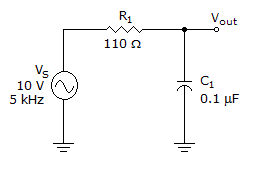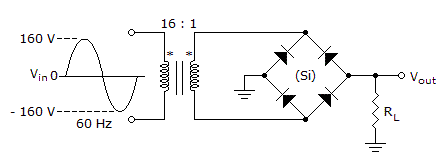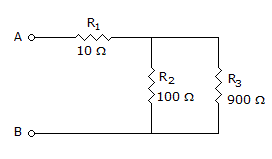Discussion
Home ‣ Electronics ‣ Bipolar Junction Transistors (BJT) See What Others Are Saying!
- Question
With a common-collector (C-C) amplifier the input is applied to the base and the output is taken from the emitter.
Options- A. True
- B. False
- Correct Answer
- True
- 1.

If the given circuit is used as a filter, the cutoff frequency is _____.
Options- A. 5 kHz
- B. 14.47 kHz
- C. less than 5 kHz
- D. more than 20 kHz
- 2. Base currents are usually small because of the physical construction of the thin and lightly doped base.
Options- A. True
- B. False Discuss
- 3. Ferromagnetic materials have minute magnetic ___ created within their atomic structure by the orbital motion and spin of electrons.
Options- A. forces
- B. flux lines
- C. domains
- D. tapes Discuss
- 4.

Connecting a capacitor filter to the circuit in the given circuit will___.
Options- A. produce a nearly-constant dc voltage
- B. reduce the output voltage
- C. increase the ripple voltage
- D. lower the surge current Discuss
- 5. ECL gates are noted for their high frequency capability and small output voltage swing.
Options- A. True
- B. False Discuss
- 6.

If the voltage between points A and B equals 9 V in the given circuit, then VR3 equals ______.
Options- A. 0.9 V
- B. 8.1 V
- C. 9 V
- D. More information is needed to find VR3. Discuss
- 7. A Thevenin equivalent circuit contains _____.
Options- A. a voltage source in series with a resistance
- B. a current source in series with a resistance
- C. resistors in a series-parallel configuration
- D. many voltage sources Discuss
- 8. For a capacitor to completely charge in an RC integrator, the pulse width must be _____ 5 time constants.
Options- A. less than
- B. greater than
- C. equal to
- D. greater than or equal to Discuss
- 9.

When the current through a coil reverses direction, the magnetic field around the coil _____.
Options- A. does not change
- B. disappears
- C. increases in strength
- D. reverses direction Discuss
- 10. A rectangular wave that has a duty cycle of 50% could be called a
Options- A. "c" wave
- B. sawtooth wave
- C. square wave
- D. triangular wave Discuss
More questions
Correct Answer: 14.47 kHz
Correct Answer: True
Correct Answer: domains
Correct Answer: produce a nearly-constant dc voltage
Correct Answer: True
Correct Answer: 8.1 V
Correct Answer: a voltage source in series with a resistance
Correct Answer: greater than or equal to
Correct Answer: reverses direction
Correct Answer: square wave
Comments
There are no comments.More in Electronics:
Programming
Copyright ©CuriousTab. All rights reserved.
